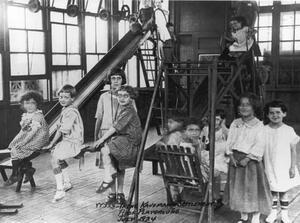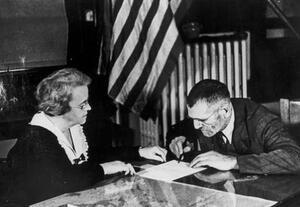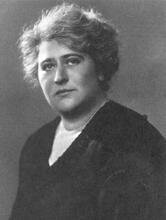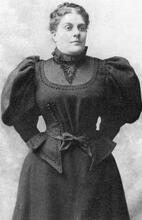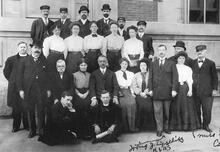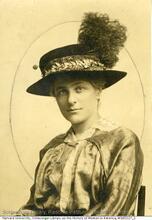Settlement Houses in the United States
Founded beginning in 1886, settlement houses served residents of impoverished urban neighborhoods, largely immigrants, by providing recreation, education, and medical and social service programs. Jewish philanthropists and board members played large roles in the funding, leadership, and upkeep of these institutions. Settlement house workers often went on to longer careers in public service. Some critics scorned settlement houses for failing to address fundamental economic inequalities. Settlement work began to slow with the outbreak of World War I and the waning of Jewish immigration, as well as increasing control of agencies in major cities and the "red scare" of 1919 that labeled many progressive settlement leaders as communist traitors. By World War II, most Jewish settlements had become community centers, though many Jewish women continued to work in nondenominational settlement houses.
Jewish women have played significant roles as benefactors, organizers, administrators, and participants in American settlement houses. Settlement houses, founded in the 1880s in impoverished urban neighborhoods, provided recreation, education, and medical and social service programs, primarily for immigrants. Although the popularity of settlement houses peaked prior to World War I, the organizations continue to serve low-income families in cities across the United States. From the start of the movement to the present, Jewish women of all backgrounds have found the settlements a congenial place to learn, teach, court, launch careers, and consolidate political power.
Beginnings of the Settlement House Movement
The settlement house movement began in America in 1886 when Stanton Coit, a disciple of Felix Adler, established Neighborhood Guild on the Lower East Side of Manhattan. Residents of the guild organized clubs for Jewish and Italian immigrant boys. A sister organization, College Settlement on Rivington Street, offered programs for immigrant girls. Supported in large part by Jewish benefactors, the organizations merged to form University Settlement. Within twenty-eight years of the Neighborhood Guild’s founding, reformers had established more than four hundred settlement houses in the United States. Though most settlements claimed to be nondenominational, prior to World War II only a few houses successfully integrated Jewish and Christian workers. In 1911, settlement worker Boris D. Bogen estimated that there were seventy-five Jewish settlements (or neighborhood centers, so called because the staff did not live there) in addition to fifty-seven non-Jewish settlements or centers dedicated to serving a Jewish population.
Reactions and Experiences
The reaction of Eastern European Jewish women to settlement houses varied considerably according to their expectations, the personality of the settlement workers they encountered, and the quality of the programs. For some female Jewish immigrants, the settlements provided opportunities unparalleled by other institutions. In Boston, Celia Stanetsky Cohen idolized her club leader, Julia Frothingham, at the North End Union, and Cohen spent hours listening to her read literature or discuss suffrage and equal rights. American democracy came alive for Cohen when she and her friends first traveled to Washington, D.C., with the club leader. Undaunted by the club leader’s Christianity, Cohen proclaimed that Frothingham had shown her the beauty of life.
Unlike Cohen, many Jewish children were forbidden to cross a settlement house’s threshold by parents who feared Christian missionaries. In 1896, Hilda Satt Polacheck of Chicago resisted an invitation to the Hull House Christmas party for fear she might be killed. When she finally entered Hull House, Jane Addams’s warm welcome and the fellowship of strangers astonished her. “Bigotry faded,” she later recalled. “I became an American at that party.” When work took Polacheck from school, Hull House became her classroom at night. For ten years, her social and educational development revolved around the settlement, and in 1904 Jane Addams arranged for Polacheck to attend the University of Chicago. Six months later, Polacheck began teaching English at Hull House, and she delighted in the transition from program participant to instructor.
Polacheck’s experience was unique. The majority of Chicago’s Jewish residents avoided Hull House but wanted similar opportunities in a Jewish context. In November 1903, the Chicago Hebrew Institute began promoting the social advancement of the Jewish residents of Chicago. This institute enabled Eastern European immigrants and German Jewish residents to work together. Goldie Tuvin Stone, a middle-class woman from Lithuania, enlisted as a volunteer and was befriended by German Jewish philanthropists, among them Julius Rosenwald, founder of Sears Roebuck.
In addition to friendship, Jewish women found romance at the settlements. When Mary Ryshpan became a student of Thomas Davidson’s at the Educational Alliance in New York City, she fell in love with and married fellow student Morris Raphael Cohen, later a renowned philosopher. Anne Schroeder, whose family could not afford the clothes necessary to send her to school at the same time as her sister, met and married fellow club member Louis Abrons at the Henry Street Settlement. With help from mentors, Herbert Lehman in particular, the Abrons family prospered and became leading benefactors of the Henry Street Settlement.
Criticism of the Movement
Immigrant journalist Rose Pastor Stokes embarked on an ill-fated marriage to patrician James Graham Phelps Stokes after they met at University Settlement in New York City. She later became one of the settlement’s most outspoken critics. She ridiculed altruists who patronized working women at settlement houses, and she blamed the settlements for increasing alienation between social classes.
Stokes was not the sole critic. Well-known figures such as Anzia Yezierska and Emma Goldman scorned the settlements as well. Yezierska worked briefly at the Emanu-El Sisterhood of Personal Service settlement in Manhattan on 82nd Street but loathed the job. Radical reformer Emma Goldman scoffed that “settlement work was teaching the poor to eat with a fork.” Other reformers thought Americanization programs failed to address the fundamental economic inequalities facing immigrants. Union member Gertrude Barnum declared that the settlements’ efforts to provide books, flowers, and music did little to raise wages or shorten working hours. But some settlement workers did confront economic issues. Jane Addams and Florence Kelley at Hull House conducted sociological investigations, and they, as well as others, lobbied politicians and supported labor unions. Early meetings of the Women’s Trade Union League were held at University Settlement.
Effect on Settlement Workers’ Lives
Many women’s lives were changed by the meaningful work they found at the settlements. Widow Rebekah Bettelheim Kohut briefly supported her family by teaching classes at the Educational Alliance, where her success brought her to the attention of reformers at the national level. She later became active in the National Council of Jewish Women and served as the first president of the New York Section (1894 to 1898). Later she participated in Woodrow Wilson’s Federal Employment Committee and in Governor Franklin D. Roosevelt’s Advisory Council on Employment in 1931, where she was one of a few recommending unemployment insurance.
Belle Moskowitz’s career began at New York’s Educational Alliance in 1900 when she was hired as the director of entertainments and exhibits. She met architect Charles Israels, who led a boys’ club at the alliance, and they were married in 1903. Ties forged during her employment at Educational Alliance led to many other opportunities. After Charles Israels’s death in 1911, she chaired a task force to study and combat immorality in dance halls, part of the campaign against white slavery, and she worked for the Dress and Waist Manufacturers Association, serving as manager of the labor department from 1914 to 1916. In 1914, she married Henry Moskowitz, an acquaintance from the Educational Alliance. Moskowitz was a former headworker of Madison Street Settlement in Manhattan and a former resident of University Settlement. Later Belle Moskowitz became Alfred Smith’s political adviser. She credited the settlements with providing an opportunity for Jewish women to combine “true womanhood,” Jewish traditions, and employment.
Lillian Wald
A settlement house launched Belle Moskowitz’s career in public service, but for Lillian Wald, founder of the famous House on Henry Street, the settlement was not merely the starting point, it was the root that sustained forty years of social reform initiative in public health, education, recreation, civil rights, housing, and employment. Raised in an affluent German-Jewish family, first in Cincinnati, Ohio, and then in Rochester, New York, Wald longed for meaningful work. From 1889 to 1891, she studied at the New York Hospital training school for nurses. In 1893, she enrolled in the Woman’s Medical College in New York City and organized home nursing classes for Lower East Side immigrants. In the spring of 1893, after visiting a patient’s squalid tenement apartment, she pledged herself to public health nursing, left medical school, and moved with Mary Brewster to College Settlement on the Lower East Side. Later they moved to their own apartment and then, with funds from Elizabeth Loeb and Jacob Schiff, Lillian Wald established the Nurses Settlement at 265 Henry Street, in 1895.
Wald welcomed immigrants from all over the world, Jews and non-Jews alike. She did not envision Henry Street as a Jewish settlement, but she relied on Jewish philanthropists to support her work. The programs attracted many Jewish immigrants who knew that there would be no missionizing at Henry Street. At times, Wald’s lack of emphasis on Jewish traditions angered her benefactors. Jacob Schiff, an observant Jew, was outraged when he learned that there had been a Christmas party with a Christmas tree at Henry Street. For the most part, however, he and his family lent their unconditional support.
Wald demonstrated that settlements could be a powerful political base for women. As a popular and knowledgeable advocate for her neighbors, Wald forged alliances with powerful reformers and politicians. She influenced significant legislation at the local, state, and national levels. Her accomplishments include convincing the New York City Board of Health to establish the first public school nursing program in the United States; helping to establish the department of nursing and health at Teachers College of Columbia University; serving as the first president of the National Organization for Public Health Nursing; founding, with Florence Kelley, the National Child Labor Committee; and playing a leading role in the creation of the federal Children’s Bureau. At Henry Street, through membership in United Neighborhood Houses of New York City and in the National Federation of Settlements, Wald set high standards for other settlements to follow. Lillian Wald’s charisma and dedication attracted many nurses and fellow reformers to Henry Street and other settlements.
Jewish Philanthropists and Leaders
German Jewish philanthropists, committed to taking care of their own people and combating antisemitism, often served on the boards of directors of settlement houses, raising money, overseeing programs, and hiring key personnel. Though these philanthropists rarely spent much time at the settlement, their contribution cannot be exaggerated. Without the support of Elizabeth Loeb and her daughters Nina Warburg and Therese Loeb Schiff, Lillian Wald would not have been able to rent or purchase buildings, pay the nurses, or staff other programs. Major supporters include Alice and Irene Lewisohn, who built, funded, and ran the Neighborhood Playhouse, a theater in the Henry Street Complex. In 1927, the playhouse closed and the settlement took it over. A year later, Irene Lewisohn, in collaboration with Rita Wallach Morgenthau, another of Wald’s close friends and supporters, founded the Neighborhood Playhouse School of the Theatre.
Board members were important for leadership as well as donations. Educator Julia Richman played a key role in creating New York City’s Educational Alliance, the first Jewish social service organization to conceive of itself as a settlement house. As a member of the board of directors of the Hebrew Free School Association, Richman demonstrated the compatibility of Americanization programs, English classes, a lending library, after-school activities, summer camp, art and music classes, and literary clubs, with Hebrew classes and efforts to preserve Jewish heritage. When the Free School Association merged with other organizations on the Lower East Side, including the New York Hebrew Institute (founded by members of the YMHA), Richman expanded the Free School to accommodate and “Americanize” Orthodox Jews arriving each year from Eastern Europe. Incorporated in 1893, and supported by German Jews from uptown, the Educational Alliance provided a model for Jewish philanthropists in other cities. By 1915, Atlanta, Baltimore, Chicago, Cleveland, Columbus (Ohio), Kansas City (Missouri), Los Angeles, and St. Louis had Educational Alliances of their own.
Richman was an active board member from 1891 to 1912, and the only female board member of the Educational Alliance until 1901. She became a mentor to many Jewish women who gravitated toward settlement work, including Belle Moskowitz and Rebekah Kohut. Although the alliance’s board rarely ceded power to women, many women joined the auxiliary committee and did important work.
Jewish Women’s Contributions to the Movement
Middle-class Jewish women contributed to the settlement movement through a variety of organizations. The Sisterhoods of Personal Service, dedicated to “overcoming the estrangement of one class of the Jewish population from another,” was founded by women of Temple Emanu-El in 1887 and was led by Hannah Bachman Einstein. Spreading to nearly every Jewish congregation in New York City, San Francisco, and St. Louis, the sisterhoods established mission schools that came to mirror programs at settlement houses. The Emanu-El Sisterhood had its own settlement at 318 East 82nd Street, as did Temple Israel, whose sisterhood founded, in 1905, the Harlem Federation for Jewish Communal Work, later renamed Federation Settlement. Einstein, who was active in many reform circles, emerged in 1909 as president of the Widowed Mothers Fund Association, a powerful proponent of widows’ pension legislation. She had many ties to settlements through her service on the Women’s Auxiliary of University Settlement from 1909 to 1912 and her agreement with Sophie Axman of Educational Alliance to help with delinquent children. In Milwaukee, sisterhood member Lizzie Black Kander established and served as the first president of the settlement. Kander and Fannie Greenbaum later compiled and published the Settlement Cook Book. With the proceeds, board members purchased a new building for the settlement.
Another group of Jewish women reformers came to the settlements via the National Council of Jewish Women (NCJW). The council’s founding in 1893 solidified the growing dedication of upper-middle-class Jewish women to the settlement movement. Julia Felsenthal of Philadelphia and Julia Richman attended the first meeting in Chicago to educate their sisters about settlements. The NCJW’s threefold mission of philanthropy, religion, and education was ideally suited to settlement work. In Chicago, Hannah Solomon and Sadie American rode the NCJW’s momentum to establish Maxwell Street Settlement in a Jewish neighborhood on the West Side. In New York, Belle Moskowitz drew on her settlement background to lead the NCJW chapter in a fight against white slavery. Through the NCJW, Jewish women supported settlements run by and for Jewish women.
Mrs. A. Leo Weil of the Pittsburgh Section of the NCJW organized the Columbian School, later called the Columbian Council School, in 1895. In 1909, the name changed to the Irene Kaufmann Settlement as a memorial to the daughter of Mr. and Mrs. Henry Kaufmann. With generous support from the Kaufmann family, the settlement blossomed, offering a district nursing service beginning in 1902, as well as a kindergarten, an employment bureau, an art school, a music school and theater program, and housing reform campaigns. The board hired its first full-time director, Sidney Teller in 1916, and by the time he and his wife Julia Pines Teller resigned in 1941, the annual budget had grown to ninety-seven thousand dollars.
The second president of New York City’s NCJW section, Rachel Hays Sulzberger chaired the committee that established Recreation Rooms for Girls at 79 Orchard Street in 1898. Its purpose was to Americanize while preserving Jewish traditions. After moving to 186 Chrystie Street in 1899, the director, Bertha F. Lubitz, guided the girls to form self-help clubs that raised money for summer outings. Opposed to Jewish participation in Christian settlement houses, Rachel Hays Sulzberger and fellow board members Mrs. Aaron Kohn, Ida Blum Straus, Theresa Loeb Schiff, and Florence Guggenheim ensured that recreation rooms provided programs such as Friday evening talks on Jewish history and literature, Saturday evening dances, and Bible and Hebrew classes run by the Jewish Endeavor Society on Sunday. In 1900, Rebekah Kohut endorsed the work of Recreation Rooms in the American Hebrew, declaring the program successful because Jewish girls were being helped by their Jewish sisters.
After 1914, with the waning of Jewish immigration and the outbreak of war in Europe, Jewish leaders began to question the scope and content of settlement work. Community chests organized in most cities, except for Chicago and New York, began to control dependent agencies. When the “red scare” of 1919 labeled many progressive settlement leaders as communist traitors, contributions fell. Furthermore, the settlements’ sympathy with labor unions and other radical organizations led to a decline in popularity and support. The federal income tax legislation passed in 1914 also eroded contributions to private social service organizations. Most important, settlement neighborhoods were changing. As African Americans replaced Jewish residents of American ghettos, Jewish social workers and philanthropists debated their mission. Should settlements follow Jewish people out of the neighborhood or adapt their programs for newcomers?
Decreasing Numbers
In 1914, Miriam Blaustein, widow of David Blaustein, renowned leader of Educational Alliance and then Chicago Hebrew Institute, praised the ideal Jewish settlement, a place that “breathes the Jewish spirit … [and] brings home to the Hebrew an historic consciousness.” She saw Jewish settlements as the place where Jewish girls could learn about the superiority of Jewish domesticity and about other Jewish women. Settlement worker Walter Solomon objected to Blaustein’s remarks, insisting that there could be no such thing as a Jewish settlement because a settlement by definition must be nonsectarian. He argued that only a community center could be Jewish, and that the settlement’s purpose was to prepare Jewish children for participation in American life rather than for the resurrection of a Jewish nation. The debate continued without resolution. Meanwhile, people moved. In 1926–1927, at eighteen representative settlements in New York City, 56 percent of program participants were Jewish. A few years later, the number dropped precipitously as the neighborhood changed.
The developments at Council House, founded in Manhattan by the New York Section of the NCJW in 1917, illustrate one group’s response to the dilemma. Opened at 74 St. Marks Place, Council House offered a meeting space for mothers and children, and classes in English, dancing, and singing. As the Jewish population began to migrate from Lower Manhattan to the Bronx, Council House moved as well. In 1929, board members erected a three-story building with a gym and playground at 1122 Forest Avenue. Council House continued until the early 1940s, when African Americans began to outnumber Jewish children in the settlement programs. In response, the NCJW drafted a lengthy report concluding that the organization should be turned over to the African-American community, with its own board and programs. At a meeting in New York City, attended by Eleanor Roosevelt, NCJW members, and local leaders from the East Bronx, Council House was renamed Forest House, with a board of directors elected from the neighborhood. The decline in Jewish program participants had weakened the commitment of Jewish supporters, and the settlement’s identity changed accordingly.
By World War II, with exceptions such as Educational Alliance in Manhattan and the Irene Kaufmann Settlement in Pittsburgh (which became a community center in 1988), most Jewish settlements had become community centers. At the same time, many Jewish women continued to work in nondenominational settlement houses as administrators, volunteers, and board members.
Bellow, Adam. The Educational Alliance: A Centennial Celebration (1990).
Berrol, Selma. “When Uptown Met Downtown: Julia Richman’s Work in the Jewish Community of New York, 1880–1912.” American Jewish History 8, no. 1 (June 1981).
Blaustein, Miriam. “Settlements in Small Southern Communities.” Jewish Charities 5, no. 1 (August 1914).
Bogen, Boris D. “Jewish Settlements.” Jewish Charities: Bulletin of the National Conference of Jewish Charities 2, no. 1 (August 1911).
“A Brief History of the Irene Kaufmann Settlement, 1895–1942.” Archives. 92nd Street Y, NYC.
Bristow, Edward J. Prostitution and Prejudice: The Jewish Fight Against White Slavery, 1870–1939 (1983).
Cremin, Lawrence A. American Education: The Metropolitan Experience, 1876–1980 (1988).
Dye, Nancy Schrom. As Equals and as Sisters: Feminism, the Labor Movement, and the Women’s Trade Union League of New York (1980).
H.B.E. [Hannah Bachman Einstein]. “Sisterhoods of Personal Service.” The Jewish Encyclopedia (1901).
Ewen, Elizabeth. Immigrant Women in the Land of Dollars: Life and Culture on the Lower East Side, 1890–1925 (1985).
Gans, Herbert J. “Redefining the Settlement’s Function for the War on Poverty.” Social Work (October 1964).
Gurock, Jeffrey S. “Jacob S. Riis: Christian Friend or Missionary Foe? Two Jewish Views.” American Jewish History 71, no. 1 (September 1981).
Henriksen, Louise Levitas. Anzia Yezierska: A Writer’s Life (1988).
Kennedy, Albert J., Kathryn Farra, et al. Social Settlements in New York City: Their Activities, Policies and Administration (1935).
Kirshenblatt-Gimblett, Barbara. “Kitchen Judaism.” In Getting Comfortable in New York: The American Jewish Home, 1880–1950 (1990).
Lissak, Rivka Shpak. Pluralism and Progressives: Hull House and the New Immigrants, 1890–1919 (1989).
Marcus, Jacob R., ed. The American Jewish Woman: A Documentary History (1981).
Moore, Deborah Dash. At Home in America: Second-Generation New York Jews (1981).
Moske, James. “Recreation Rooms and Settlement Collection.” Guide to Brooklyn Historical Society collection (1994).
NAW, s.v. “Belle Lindner Israels Moskowitz,” “Hannah Bachman Einstein,” and “Lillian D. Wald."
NAW modern, s.v. “Rebekah Bettelheim Kohut."
Perry, Elisabeth Israels. Belle Moskowitz: Feminine Politics and the Exercise of Power in the Age of Alfred E. Smith (1987).
Polacheck, Hilda Satt. I Came a Stranger: The Story of a Hull-House Girl. Edited by Dena J. Polacheck Epstein (1989).
Rabinowitz, Benjamin. The Young Men’s Hebrew Associations, 1854–1913 (1948).
Rogow, Faith. Gone to Another Meeting: The National Council of Jewish Women, 1893–1993 (1993).
Rothenberg, Flora R. “Story of Council House.” Unpublished paper (1985).
Siegel, Beatrice. Lillian Wald of Henry Street (1983).
Solomon, Walter Leo. “The Jewish Settlement Again.” Jewish Charities 5, nos. 8 and 10 (1915).
Straus, Mrs. Isidor. “The Recreation Room for Girls.” Jewish Charity: A Monthly Review of General Jewish Charity 4, no. 4 (January 1905).
Trolander, Judith Ann. Professionalism and Social Change: From the Settlement House Movement to Neighborhood Centers, 1886 to the Present (1987), and Settlement Houses and the Great Depression (1975).
University Settlement. Annual Reports (1909–1912).

